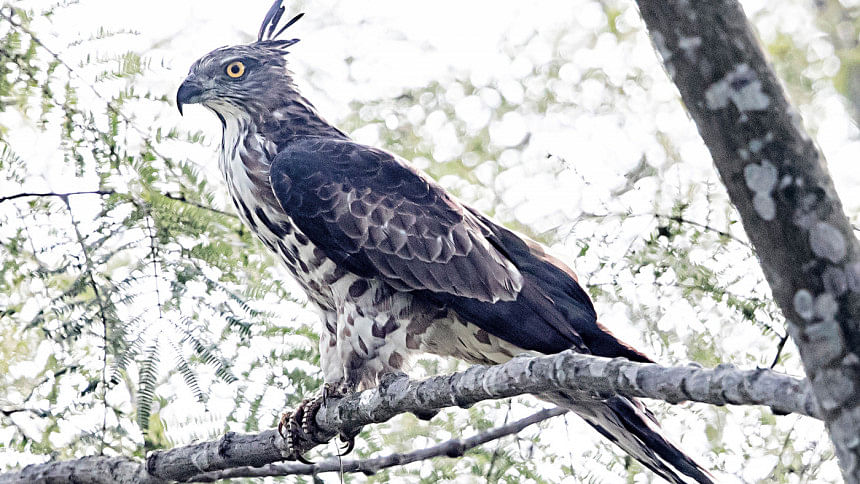Birds of Prey

Birds of prey capture our imagination for many possible reasons. It could be their display of power and agility. It could be their spare, elegant beauty. It could be our ancient memory from hunter-gatherer ancestors. Seeing a bird of prey – also known as a raptor - whether it is sitting or flying or attacking can be an exciting moment.
And there is a wealth of raptors to see in Bangladesh: approximately thirty-five species, not counting owls and vultures (which swells their rank to fifty-ish species.) Some of them arrive for the winter while others live here year-round.
Except for Brahminy and Black Kites (cheels), raptors are shy. So where does one find them?
Some are found in open spaces, circling the sky while scanning the fields for prey. Close to Dhaka, I have seen them over the grasslands of Purbachol. The Common Kestrel, a small falcon, can be easily seen there in winter, a reddish bird perched atop electric poles. Larger raptors circle high overhead. While most are cheels, I have seen Booted and Steppe Eagles, Japanese Buzzards and Oriental Honey-Buzzards among them, discernible from photographs or with binoculars. The Black-winged Kite breeds in Purbachol. A magnificent black-and-white hunter, it sometimes hovers at one spot while looking for prey.
Going farther from Dhaka, our haors and chars host several raptors. Harriers fly slow and low over haor grass to find their meal. Over the haor waters you can see powerful hunters of fish: Pallas's and Grey-headed Fish Eagles and Ospreys. Baikka Beel and the surrounding Hail Haor in Molvi Bazar is a good place to find these raptors, either in the sky or sitting on the ground at the edge of fishponds.
Birders visit chars of the Padma river in Rajshahi for waterfowl and shore birds but these places are also rich in raptors. I have seen numerous Peregrine Falcons there, including the rare Shahin subspecies. In the skies above the Padma, eagles and harriers can be seen. While birding there, it is easy to miss a raptor fly past overhead because, sitting on our boat, our eyes are on the water and sand searching for birds.
Our forests hold another set of raptors but they are harder to find. The Shikra, a cousin of the Sparrowhawk, is our common forest raptor. It is present in virtually every forest, but most easily seen in Sundarban. Its smaller relative, Besra, is harder to spot. Perhaps the most intriguing forest raptors are the two bazas, easily recognized by the erect black crests over their head. I have seen Jerdon's Bazas in Sylhet's tea gardens and Bandarban. Rare Black Bazas, with striking black and white wing patterns, are winter migrants. I have seen them over the skies of Satchori National Park in Habiganj, which also hosts several other forest raptors including the Crested Goshawk.
Any discussion of our raptors would be incomplete without the Crested Serpent Eagle, a large brown bird found at the edge of forests and in villages. It can sit still for hours atop a tree, its powerful eyes scanning up to half a mile, looking for a snake. Its legs are covered in tough skin to protect against snakebites.
Raptors are harder to find than other kinds of birds, but the patience and hard work in finding them is amply rewarded by the excitement they bring.
www.facebook.com/ikabirphotographs or follow "ihtishamkabir" on Instagram.

 For all latest news, follow The Daily Star's Google News channel.
For all latest news, follow The Daily Star's Google News channel. 



Comments